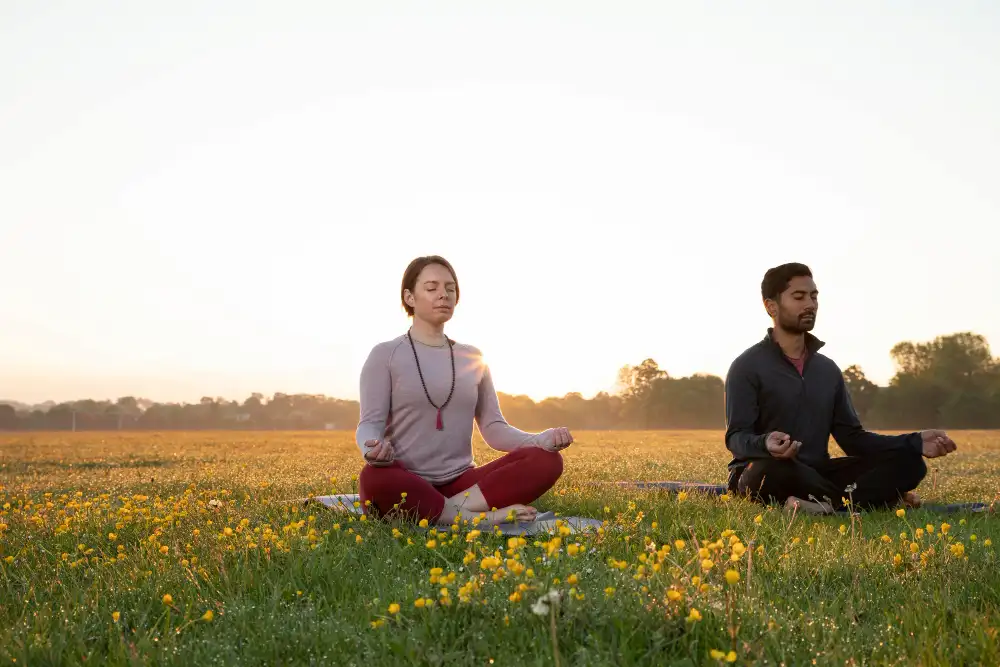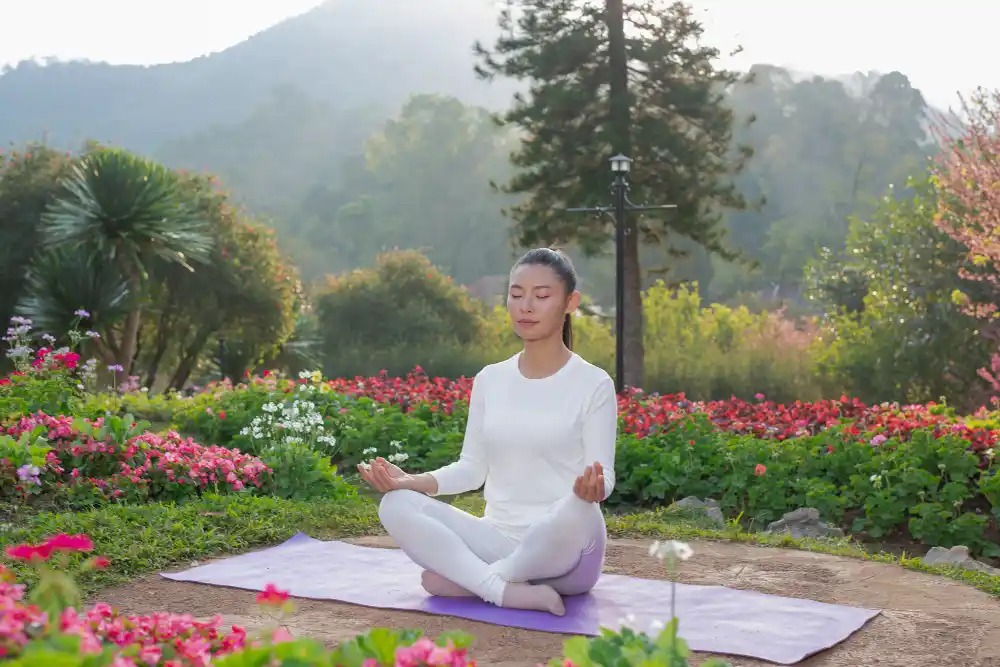Meditation has long been recognized for its ability to improve mental and physical health. Among its various forms, guided meditation stands out for its accessibility and ease of practice, especially for beginners.
This blog post will introduce you to what is guided meditation, its benefits, and how it differs from other meditation practices. We’ll explore the role of a guide, the different formats available, and how these sessions can help reduce stress, enhance focus, and promote emotional well-being.

What is Guided Meditation?
Guided meditation is a form of meditation where a guide or instructor verbally leads an individual through a meditation session. This guidance can be delivered in person, through an audio recording, or even via a video.
The guide provides step-by-step instructions to help participants focus their attention, visualize scenarios, or practice mindfulness techniques designed to promote relaxation, stress relief, and mental clarity.
The content of a guided meditation session can vary widely, from focusing on breath control to starting a visual journey in the mind’s eye to a peaceful place. The yoga teachers can also suggest imagining healing processes within the body, cultivating feelings of love and kindness, or observing thoughts and sensations without judgment.
This form of meditation is particularly helpful for beginners who find it challenging to direct their focus or for those seeking specific outcomes from their meditation practice, like improved sleep, reduced anxiety, or enhanced emotional health.
By following the voice and instructions of the guide, participants can more easily enter a state of deep relaxation and mindfulness, making the practice accessible and effective for people at all levels of experience.
Guided Meditation Benefits

Let’s know about the top benefits of guided meditation:
1. Reduce Stress
One of the most immediate benefits of guided meditation is its ability to significantly reduce stress. The practice encourages relaxation of the mind and body, helping to lower levels of the stress hormone cortisol. This can lead to improvements in symptoms related to stress, such as anxiety, high blood pressure, and chronic pain.
2. Enhance Concentration and Focus
Guided meditation involves focusing on a particular object, thought, or breath, which can train the mind to maintain focus over longer periods. This improved concentration can benefit various aspects of life, from work performance to daily activities, by helping individuals stay more present and engaged.
3. Improve Emotional Health and Well-being
Regular guided meditation can lead to an increase in positive emotions and a decrease in negative emotions. By fostering a state of mindfulness, individuals can better observe their thoughts and feelings without judgment, leading to improved self-esteem and a more positive outlook on life. It can also assist in managing symptoms of depression and anxiety.
4. Better Sleep Quality
Guided meditation can be particularly effective in improving sleep quality. By promoting relaxation and easing the mind, it helps individuals fall asleep more quickly and achieve deeper, more restorative sleep. This can be especially beneficial for those suffering from insomnia or sleep disturbances.
5. Pain Management
Guided meditation plays a role in pain management. By focusing the mind and reducing stress, individuals may experience a decreased perception of pain. Meditation has been used as a complementary approach to traditional pain management techniques in various medical settings.
6. Increase Self-awareness
Guided meditation encourages reflection and mindfulness, which can increase self-awareness. This heightened sense of self can lead to a better understanding of one’s thoughts, feelings, and behaviors, contributing to personal growth and improved relationships.
7. Emotional Regulation and Resilience
Practicing guided meditation helps individuals develop skills in emotional regulation, making it easier to manage challenging emotions and reactions. This resilience can enhance coping strategies in stressful situations, leading to greater emotional stability.
8. Enhanced Creativity and Problem-solving Abilities
Guided meditation can open up mental space for creativity and innovative thinking by calming the mind and reducing overthinking. This relaxed state of mind is conducive to generating new ideas and finding solutions to problems.
9. Connection with the Present
Guided meditation emphasizes mindfulness or the practice of being fully present and engaged at the moment. This can help reduce rumination on the past or worry about the future, enhancing overall quality of life.
10. Improve Levels of Dehydroepiandrosterone (DHEA)
Among the myriad benefits of guided meditation, one notable physiological effect is its ability to improve levels of Dehydroepiandrosterone (DHEA) in the body.
DHEA is a hormone produced by the adrenal glands, serving as a precursor to male and female sex hormones and playing a crucial role in maintaining various bodily functions, including immune response, skin health, and energy levels.
Studies suggest that regular meditation practice can lead to increased DHEA levels, which is associated with enhanced well-being, reduced stress, improved cognitive function, and a potential slowing of the aging process.
11. Improve Overall Health
The stress-reduction benefits of guided meditation can also have positive effects on physical health, including lower blood pressure, reduced risk of heart disease, and improved immune function.
Guided Meditation Techniques

Guided meditation includes a variety of techniques to cater to different needs and preferences. These techniques are designed to help participants enter a state of deep relaxation, enhance mindfulness, or achieve specific personal goals:
1. Visualization
Visualization is a powerful technique where the guide instructs participants to form mental images of places, situations, or items that are calming and peaceful. This could involve imagining a serene beach, a lush forest, or even visualizing oneself achieving future goals.
The vividness of the imagery can engage the mind in a positive and relaxing manner, helping to reduce stress and promote a sense of inner peace. Join an online meditation course for the best experience.
2. Body Scan
The body scan technique includes mentally scanning one’s own body from head to toe, starting at the feet and moving upwards.
The yoga teacher leads participants through noticing sensations in each part of the body, encouraging them to observe without judgment and release tension where it’s found. This practice helps to cultivate bodily awareness and can be particularly effective for stress relief and relaxation.
3. Mindfulness Meditation
In mindfulness meditation, the guide helps participants focus on the present moment, starting with the breath.
Participants are encouraged to observe their thoughts, feelings, and bodily sensations as they arise, without trying to change or judge them. This technique helps to develop a deeper awareness of the present, reducing stress and enhancing emotional balance.
4. Loving-kindness Meditation (Metta)
Loving-kindness meditation focuses on cultivating feelings of love, kindness, and compassion towards oneself and others.
The guide leads participants through the process of sending well-wishes to themselves, loved ones, neutral individuals, and even those with whom they may have difficulties. This practice can improve emotional well-being, increase positive emotions, and enhance interpersonal relationships.
To improve your emotional intelligence, you can consider joining the online emotional intelligence courses.
5. Focused Attention
This guided meditation technique involves concentrating on a single point of focus, such as the breath, a mantra, or a specific object.
The guide helps participants to return their attention to the focal point whenever they notice their mind wandering. Focused attention meditation is effective for enhancing concentration, mental clarity, and mindfulness.

6. Progressive Relaxation
Also known as progressive muscle relaxation, this technique includes tensing and then relaxing different muscle groups in the body. The guide leads participants through the process, often starting at one end of the body and working through to the other.
This method is particularly effective for releasing physical tension and can aid in relaxation and stress relief.
7. Guided Imagery
Similar to visualization but more narrative in nature, guided imagery involves the guide telling a story with vivid descriptions to engage the participant’s imagination. The scenarios are typically designed to evoke feelings of calmness and relaxation.
This technique of guided meditation can be particularly engaging and effective for those who enjoy storytelling and narrative exploration.
8. Breath Awareness Meditation
This simple yet powerful guided meditation technique focuses on the breath. Participants are guided to observe the natural rhythm of their breathing, noting the rise and fall of their chest or the sensation of air passing through their nostrils. This practice helps to anchor the mind in the present moment, promoting relaxation and mindfulness.
How to Choose Right Guided Meditation?

Choosing the right guided meditation can significantly enhance your meditation experience, ensuring that it meets your personal needs and preferences.
1. Identify Your Goals
Start by clarifying what you want to achieve with meditation. Are you looking to reduce stress, improve sleep, enhance concentration, or maybe develop a sense of inner peace?
Your goal will guide your choice, as different meditations focus on different outcomes.
2. Consider Your Experience Level
If you’re new to meditation, look for beginner-friendly online yoga courses that introduce the basics of guided meditation, such as focusing on the breath or simple mindfulness practices.
For more experienced meditators, advanced meditation courses explore deeper aspects of meditation might be more beneficial.
3. Duration Matters
Consider how much time you can realistically dedicate to meditation. If you’re just starting or have a busy schedule, you might prefer shorter sessions (5-10 minutes). As you become more comfortable with meditation or if you have more time, you can gradually move to longer sessions.
4. Music and Sound Effects
Some guided meditations include background music or nature sounds, which can enhance the experience for some but might be distracting for others. Consider your preference for these elements and choose accordingly.
5. Platform or Source
Guided meditations are available through various platforms, including online meditation courses, mobile apps, websites, podcasts, and YouTube. Some platforms may offer features like progress tracking, personalized recommendations, or community support, which can be beneficial depending on your preferences.
6. Specific Techniques Used
As mentioned, there are various techniques used in guided meditation, such as mindfulness, visualization, or body scans. Think about which techniques resonate with you or align with your goals, and choose meditations that incorporate these practices.
7. Trial and Error
Finally, be open to trying different meditations to find what works best for you. Meditation is a highly personal experience, and what works for one person may not work for another. Don’t hesitate to explore various guides, styles, and formats.
Getting the Most Out of Guided Meditation
To maximize the benefits of guided meditation, it’s essential to approach your practice with intention and mindfulness. Below are some strategies to help you get the most out of your guided meditation sessions:
1. Create a Conducive Environment
- Quiet Space: Find a quiet, comfortable place where you won’t be disturbed. This helps in reducing distractions and allows you to focus more deeply on the meditation.
- Comfortable Position: Sit or lie down in a comfortable position. You don’t have to adopt a traditional meditation posture if it’s not comfortable for you. The key is to ensure your body is relaxed.
2. Make It a Regular Practice
- Consistency: Try to meditate at the same time each day to establish a routine. Consistency enhances the benefits of meditation over time.
- Set a Schedule: Incorporate meditation into your daily schedule. Even just a few minutes a day can make a significant difference.
3. Be Open and Patient
Approach meditation with an open mind. The experience can vary from day to day, and being open to whatever arises is part of the process.
Also, don’t expect immediate results. The benefits of meditation often accumulate gradually over time. Be patient with yourself and the process.
4. Engage Fully with the Practice
Listen actively to the guide’s instructions and engage fully with the practice, even if your mind wanders. Try your best to follow the guide’s prompts and instructions, even if they don’t resonate with you immediately. Over time, you may find deeper meaning in them.
5. Reflect Afterward
Consider keeping a meditation journal. After each session, spend a few minutes writing about your experience, what you noticed, and how you feel.
Moreover, try to regularly reflect on any changes you notice in your stress levels, emotional well-being, or general outlook on life since beginning your practice.

6. Personalize Your Practice
Don’t hesitate to adjust the length, type, or frequency of your meditations to better suit your needs and lifestyle. Experiment with different guides and meditation styles to find what resonates most with you.
7. Integrate Insights into Daily Life
Try to carry the mindfulness cultivated during meditation into your daily life. This could mean being more present during conversations, eating, or even while walking. Use techniques learned in guided meditations, like deep breathing or mindfulness, to manage stress or challenging situations outside of your meditation sessions.
8. Use Technology Wisely
Use the best online meditation courses to explore various guided meditations and find your favorites.
Ensure your device is in “Do Not Disturb” mode during meditation to prevent interruptions.
FAQs About Guided Meditation
Unlike self-guided meditation, where you meditate on your own using techniques like mindfulness or concentration, guided meditation provides explicit instructions throughout the session. This can make it easier for beginners to focus and stay engaged, as the guide helps direct your attention and intention.
Yes, guided meditation can be very effective, especially for those new to meditation or those who prefer structured meditation sessions. It can reduce stress, improve concentration, enhance emotional well-being, and help with sleep among other benefits.
Guided meditation has been linked to numerous health benefits, including reduced stress, lower blood pressure, reduced anxiety and depression symptoms, better sleep, and improved immune system function. Regular practice can contribute to overall better physical and mental health.
Guided meditation sessions can vary in length, from a few minutes to an hour or more. For beginners, starting with shorter sessions (5-10 minutes) and gradually increasing the duration can be a good approach. The right length depends on your schedule, comfort level, and meditation goals.
No special equipment is required for guided meditation. All you need is a quiet space where you can relax without interruption. Some people prefer to use headphones to listen to guided meditations, but they are not necessary.
Yes, one of the benefits of guided meditation is its flexibility. You can practice it in any quiet space where you can listen to the guidance, whether it’s at home, in a park, or in a private office. Some guided meditations are even designed for walking or other activities.
The frequency of practice depends on your personal goals and schedule. Many people find daily practice beneficial for maintaining mindfulness and reducing stress. However, even occasional practice can be beneficial. The key is consistency and making meditation a regular part of your routine.
Guided meditation can be a helpful tool in managing anxiety and depression. It teaches relaxation techniques, helps improve mood, and provides a break from daily stressors. However, it should not replace professional treatment but can be used as a complementary practice.
Conclusion
Guided meditation is an excellent tool for strengthening mindfulness and self-regulation to manage stress more effectively. It helps you meditate, slow down your brain, enjoy life, and accept yourself. So take back your power and get control over yourself. Meditation is the most important investment you can make in yourself.


